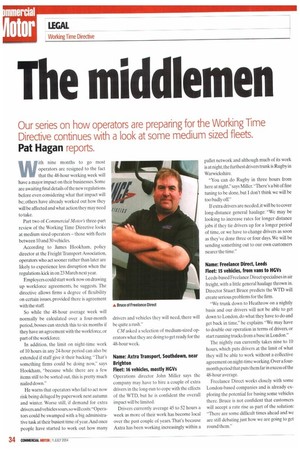The middlemen
Page 34

Page 35

If you've noticed an error in this article please click here to report it so we can fix it.
Our series on how operators are preparing for the Working Time Directive continues with a look at some medium sized fleets.
Pat Hagan reports.
With nine months to go most operators are resigned to the fact that the 48-hour working week will have a major impact on their businesses. Some are awaiting final details of the new regulations before even considering what that impact will be; others have already worked out how they will be affected and what action they may need to take.
Part two of Commercial Motor's three-part review of the Working lime Directive looks at medium sized operators — those with fleets between 10 and 30 vehicles.
According to James Hookham, policy director at the Freight Transport Association, operators who act sooner rather than later are likely to experience less disruption when the regulations kick in on 23 March next year.
Employers could start work now on drawing up workforce agreements, he suggests. The directive allows firms a degree of flexibility on certain issues, provided there is agreement with the staff.
So while the 48-hour average week will normally be calculated over a four-month period, bosses can stretch this to six months if they have an agreement with the workforce, or part of the workforce.
In addition, the limit on night-time work of 10 hours in any 24-hour period can also be extended if staff give it their backing. "That's something firms could be doing now," says Hookham, "because while there are a few items still to be sorted out, this is pretty much nailed down."
He warns that operators who fail to act now risk being deluged by paperwork next autumn and winter. Worse still, if demand for extra drivers and vehicles soars, so will costs:"Operators could be swamped with a big administrative task at their busiest time of year. And once people have started to work out how many drivers and vehicles they will need, there will be quite a rush."
CM asked a selection of medium-sized operators what they are doing to get ready for the 48-hour week.
Name: Axtra Transport, Southdown, near Brighton Fleet: 16 vehicles, mostly HGVs Operations director John Miller says the company may have to hire a couple of extra drivers in the long-run to cope with the effects of the WTD, but he is confident the overall impact will be limited.
Drivers currently average 45 to 52 hours a week as more of their work has become local over the past couple of years. That's because Axtra has been working increasingly within a pallet network and although much of its work is at night,the furthest drivers trunk is Rugby in Warwickshire.
"You can do Rugby in three hours from here at night," says Miller. "There's a bit of fine tuning to be done, but I don't think we will be too badly off."
If extra drivers are needed, it will be to cover long-distance general haulage: "We may be looking to increase rates for longer distance jobs if they tie drivers up for a longer period of time, or we have to change drivers as soon as they've done three or four days. We will be sending something out to our own customers nearer the time."
Name: Freelance Direct, Leeds Fleet: 15 vehides, from vans to HGVs Leeds-based Freelance Direct specialises in air freight, with a little general haulage thrown in. Director Stuart Bruce predicts the WTD will create serious problems for the firm.
"We trunk down to Heathrow on a nightly basis and our drivers will not be able to get down to London, do what they have to do and get back in time." he explains. "We may have to double our operation in terms of drivers, or start running trucks from a base in London."
The nightly run currently takes nine to 10 hours, which puts drivers at the limit of what they will be able to work without a collective agreement on night-time working. Over a fourmonth period that puts them far in excess of the 48-hour average.
Freelance Direct works closely with some London-based companies and is already exploring the potential for basing some vehicles there. Bruce is not confident that customers will accept a rate rise as part of the solution: "There are some difficult times ahead and we are still debating just how we are going to get round them." Name: Andrew Wishart and Sons Kirkcaldy, Scotland Fleet: 18 trucks Andrew Wishart's 18-strong fleet is split halfand-half between long-haul HGVs and smaller vehicles that work as part of a pallet network.
The nine pallet delivery drivers already work an average 48-hour week, says MD Andrew Wishart, so the directive will have no impact on them. The other nine HGV drivers average about 50 hours at the moment. Wishart hopes to get round this by picking up more local work, thereby shortening working hours, rather than hiring extra drivers.
He also plans to talk to customers about the effects the WTD will have to see if they could provide more staff for loading and unloading vehicles. "At the moment I don't think I will need to take on more drivers," he says.


































































































































































































